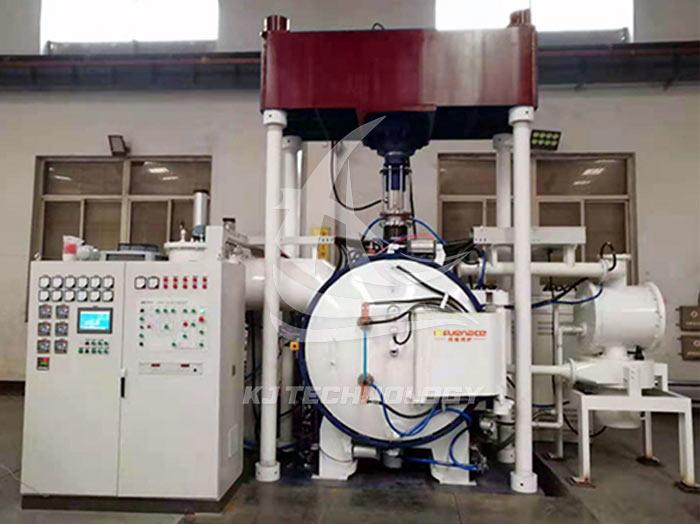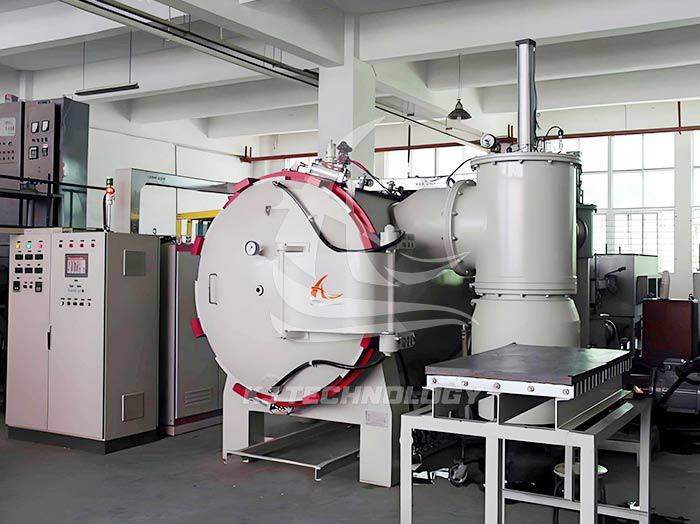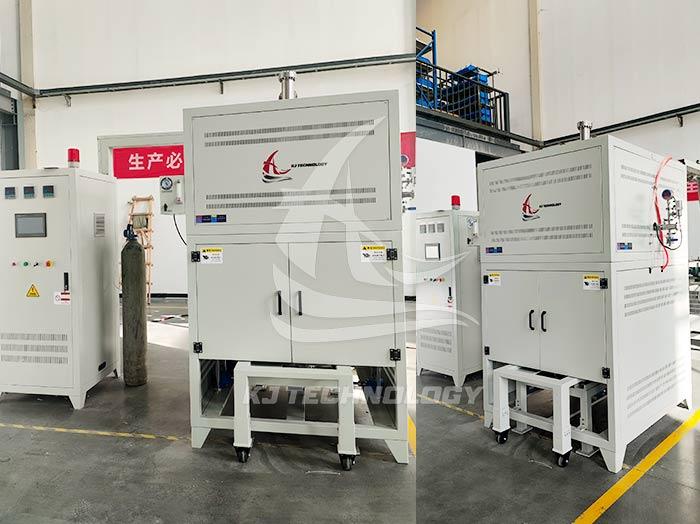Can a vertical graphite vacuum furnace be filled with atmosphere?
 09-03-2025 Author: KJ technology
09-03-2025 Author: KJ technology
The vertical graphite vacuum furnace can pass through the atmosphere, and through precise atmosphere control, it significantly improves the stability and controllability of material heat treatment. The specific analysis is as follows:
1. Technical principle: synergistic effect of vacuum and atmosphere control
The vertical graphite vacuum furnace achieves the synergy of two core functions by integrating a vacuum system and an atmosphere control system:
Vacuum environment construction:
Use a rotary vane pump or molecular pump to evacuate the furnace chamber of oxygen and impurity gases (such as water vapor), creating a high vacuum environment. This process can effectively suppress oxidation reactions, prevent the material from generating CO/CO ₂ with oxygen at high temperatures, and reduce the interference of gas molecules on thermal radiation, thereby improving heating efficiency.
Accurate control of atmosphere:
On the basis of a vacuum environment, specific gases (such as argon, nitrogen, hydrogen, etc.) are introduced through the inlet, and the gas ratio and flow rate are precisely adjusted using a mass flow controller (MFC). For example, in the preparation of graphene powder, high-purity single-layer graphene can be successfully prepared by controlling the H ₂/N ₂ mixed atmosphere and high temperature of 1000 ℃; In the sintering of LiCoO ₂ cathode material for lithium-ion batteries, precise control of O ₂ content and 1100 ℃ temperature field can improve the capacity retention rate of the product.
2. Equipment structure: Hardware design supporting atmosphere control
The vertical graphite vacuum furnace achieves precise and stable atmosphere control through the following structural optimization:
Multi inlet design:
The ventilation end can be equipped with one or more air inlets, each of which is equipped with a needle valve and can independently adjust the gas flow rate. For example, in CVD deposition experiments, it is necessary to simultaneously introduce methane (CH ₄) and hydrogen (H ₂), and the precise ratio of the two gases can be achieved through a multi inlet design to ensure the quality of thin film deposition.
Vacuum and atmosphere linkage control:
The exhaust end is connected to the exhaust hole and vacuum hole, both equipped with needle valves, which can achieve rapid switching between vacuum and atmosphere. For example, in powder metallurgy sintering, it is necessary to first evacuate to 10 ⁻ ³ Pa to eliminate air, and then introduce argon gas to 1000 mbar to form a protective atmosphere to avoid oxidation of the powder material.
Closed loop water cooling system:
Equipped with a cooling water circulation device (flow rate ≥ 40 L/min), it can quickly cool the furnace body and prevent gas expansion at high temperatures from causing the furnace body to rupture. At the same time, the water cooling system can stabilize the temperature field inside the furnace, improve temperature uniformity, and ensure consistency in material heat treatment.
3. Application scenario: Atmosphere control enhances material performance
The vertical graphite vacuum furnace achieves significant improvement in material properties through atmosphere control in the following scenarios:
Powder metallurgy sintering:
Introducing argon gas in a vacuum environment can prevent the oxidation of powder materials, while utilizing hydrogen gas to reduce oxide impurities and improve material purity. For example, in the sintering of hard alloys, by precisely controlling the hydrogen flow rate, the oxygen content in tungsten carbide (WC) powder can be reduced, significantly improving the hardness and wear resistance of the material.
Semiconductor Process Annealing:
Introducing high-purity nitrogen gas in a vacuum environment can create an oxygen free environment and prevent oxidation of the silicon wafer surface. Meanwhile, nitrogen serves as a protective atmosphere, which can stabilize the temperature field inside the furnace and improve the uniformity of annealing. For example, in transistor manufacturing, by precisely controlling the nitrogen flow rate and annealing temperature, the uniformity of silicon wafer resistivity can be improved to meet the needs of high-end chip manufacturing.
Pre sintering of ceramic materials:
Introducing a small amount of oxygen in a vacuum environment can promote the decomposition of organic compounds in ceramic materials while avoiding excessive oxidation that can cause material cracking. For example, in the pre sintering of alumina ceramics, by precisely controlling the oxygen flow rate and sintering temperature, the material density can be increased, significantly improving the material strength and insulation performance.
4. Operational advantage: Intelligent control enhances process stability
The vertical graphite vacuum furnace achieves automation and precision of atmosphere control through an intelligent control system
PLC+WINCC visual control:
Using Siemens PLC controller and WINCC visual management system, real-time monitoring and adjustment of furnace temperature, pressure, and gas flow can be achieved. For example, in graphene preparation, the system can automatically record the H ₂/N ₂ ratio and temperature curve, ensuring process repeatability and improving product consistency.
Multiple security protection mechanisms:
Built in temperature gradient control, water flow monitoring, and pressure interlock device can monitor the status inside the furnace in real time, avoiding accidents caused by rapid temperature changes or gas leaks. For example, during the vacuum pumping process, if there is insufficient water flow or abnormal pressure, the system will automatically stop heating and sound an alarm to ensure equipment safety.
Modular design scalability:
Vacuum pump units and gas purification systems can be expanded according to laboratory needs to improve equipment performance. For example, in semiconductor material annealing, by expanding the high vacuum pump group, the ultimate vacuum degree can be increased to meet the high-end material processing requirements.








